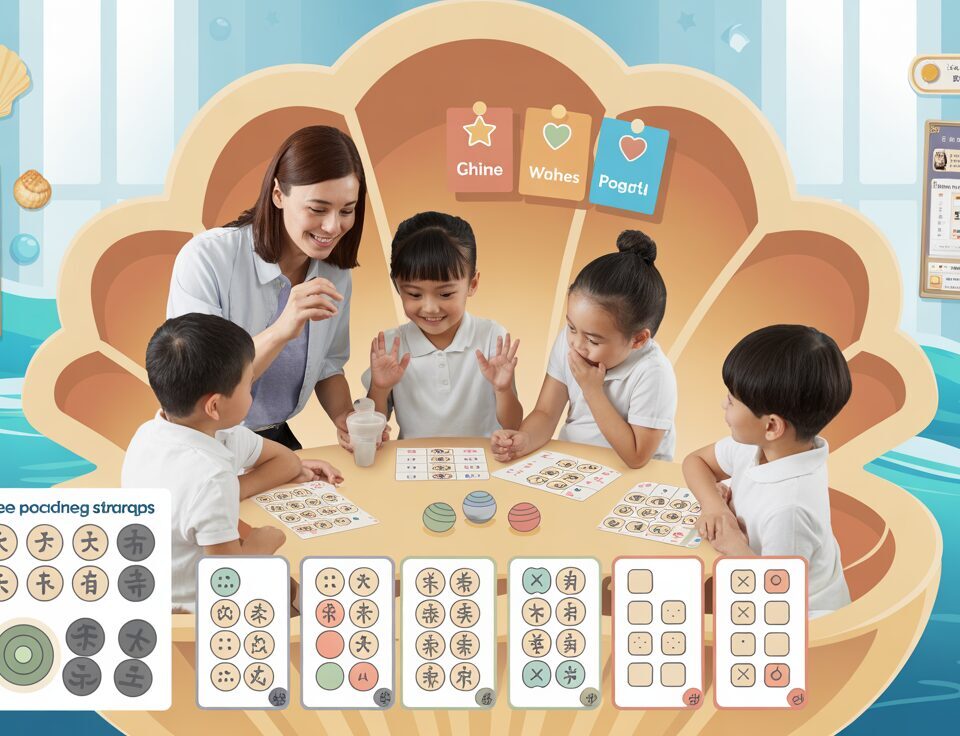
Comprehensive Checklist for Choosing the Best Science Tuition Centre in Singapore
October 31, 2025
30 High-Impact Chinese Connectors for Better Composition: Master Essential Language Tools
November 3, 2025Table Of Contents
- Understanding PSLE Chinese Oral Examination
- Key Challenges in Picture Description
- The Seashell Method for Picture Description
- Essential Vocabulary for Picture Description
- Sentence Structures That Impress Examiners
- Common Scenarios and How to Describe Them
- Beyond Description: Adding Depth to Your Response
- Building Confidence Through Practice
- How Seashell Academy Prepares Students for Success
- Conclusion: Mastering Picture Description for Long-term Success
Picture description is often considered the most challenging component of the PSLE Chinese Oral examination. Many students find themselves struggling to articulate their thoughts clearly in Mandarin when presented with an unfamiliar image. The pressure of the examination setting can further compound these difficulties, leading to hesitation, limited vocabulary usage, and underdeveloped responses.
At Seashell Academy by Suntown Education Centre, we understand these challenges intimately. Our experience working with hundreds of primary school students has shown that picture description anxiety isn’t just about language proficiency—it’s about confidence, structured thinking, and having the right approach. The good news is that with proper guidance and consistent practice, any student can master this crucial skill.
This comprehensive guide shares our proven Seashell Method for picture description—a systematic approach that helps students observe effectively, organize their thoughts logically, and express their ideas with clarity and confidence. Whether your child struggles with vocabulary recall, sentence formation, or simply knowing what to say, the techniques outlined here will transform their approach to PSLE Chinese Oral examinations.
Understanding PSLE Chinese Oral Examination
The PSLE Chinese Oral Examination consists of two main components: Reading Aloud (朗读) and Picture Description with Conversation (看图说话与会话). While both sections are important, the picture description segment often determines how well students can demonstrate their true language proficiency and thinking skills.
In this component, students are shown a picture depicting a scenario—typically a situation relevant to daily life, social issues, or moral lessons. Students are given approximately 10 minutes to prepare before being asked to describe what they see and respond to follow-up questions based on the image. Examiners evaluate students based on content, vocabulary usage, pronunciation, fluency, and the ability to engage in meaningful conversation.
What many parents and students don’t realize is that examiners aren’t simply looking for memorized phrases or perfect grammar. They’re assessing a student’s ability to observe details, make connections, express original thoughts, and communicate effectively in Mandarin. This requires a combination of language skills, critical thinking, and confidence—all of which can be systematically developed with the right approach.
Key Challenges in Picture Description
Before exploring solutions, it’s important to understand the common difficulties students face during picture description:
Limited Vocabulary: Many students know what they want to say in English but struggle to find the equivalent Chinese words, especially for describing emotions, actions, or abstract concepts.
Unstructured Responses: Without a clear framework, students often jump between observations randomly, creating disjointed descriptions that lack coherence and logical flow.
Surface-Level Observations: Most students describe only the obvious elements in a picture without delving into relationships between characters, emotions, causes, or implications—missing opportunities to demonstrate deeper thinking.
Repetitive Language: Overreliance on basic sentence structures and connector words creates monotonous responses that fail to showcase language versatility.
Anxiety and Mental Blocks: The pressure of the examination situation can cause even well-prepared students to freeze, forget vocabulary, or rush through their responses.
At Seashell Academy by Suntown Education Centre, we’ve developed our Seashell Method specifically to address these challenges, transforming picture description from a source of anxiety into an opportunity for students to shine.
The Seashell Method for Picture Description
Just as a seashell protects the delicate pearl forming within, our Seashell Method provides students with a protective framework that nurtures their ability to express themselves confidently. This three-step approach—Observe, Organize, Express—builds upon itself to create comprehensive, well-structured responses.
Step 1: Observe Systematically
Effective observation is the foundation of successful picture description. Rather than random scanning, we teach students to analyze the image systematically:
Who: Identify all people in the picture—their approximate age, gender, appearance, and relationship to each other. Look for clues in their clothing, posture, and facial expressions.
What: Determine the main actions taking place. What are people doing? What objects are significant? What problem or situation is being depicted?
Where: Identify the setting—is it indoors or outdoors? A home, school, park, or public place? What time of day or season might it be?
When: Look for clues about timing—is this showing a sequence of events? Is it depicting a special occasion or everyday activity?
Why/How: Consider the motivation behind the actions or the causes of the situation shown. How are people feeling and why?
We teach students to mentally divide the picture into quadrants and scan systematically, ensuring no important details are missed. This methodical approach prevents the common problem of focusing only on the central elements while overlooking valuable contextual details.
Step 2: Organize Your Thoughts
Once observations are complete, students need to organize these details into a coherent structure. The Seashell Method uses a simple yet powerful framework:
Introduction: Begin with a general statement that captures the main scene or theme of the picture (1-2 sentences).
Main Content: Describe specific details following a logical progression:
– Start with the main subjects/characters and their actions
– Move to secondary elements and background details
– Highlight any interesting or unusual elements
– Describe expressions, emotions, or atmosphere
Conclusion or Inference: End with a statement about the possible message, lesson, or implication of the scene (1-2 sentences).
At Seashell Academy by Suntown Education Centre, we use mind-mapping techniques to help students visualize this structure, creating logical connections between elements that make their responses flow naturally. This organization step is crucial—it’s what transforms scattered observations into a coherent narrative.
Step 3: Express with Clarity
With observations gathered and organized, the final step is expressing ideas clearly and confidently. We focus on:
Varied Sentence Structures: Combining simple statements with more complex sentence patterns that show cause-effect relationships, temporal sequences, or contrasting elements.
Precise Vocabulary: Using specific, vivid words rather than general terms—not just “happy” (高兴) but “delighted” (欢喜) or “thrilled” (兴高采烈).
Appropriate Connectors: Using a variety of transitional words and phrases that create flow between ideas: 首先 (first), 然后 (then), 不但…而且… (not only…but also…), 因为…所以… (because…therefore…).
Natural Delivery: Speaking at an appropriate pace with natural intonation and expression that conveys understanding of the content.
This three-step approach forms the core of our Seashell Method, providing students with a reliable process they can apply to any picture they encounter, regardless of complexity or topic.
Essential Vocabulary for Picture Description
Vocabulary limitations often constrain students’ ability to express what they observe. At Seashell Academy by Suntown Education Centre, we systematically build students’ descriptive vocabulary in categories most relevant to PSLE picture description:
Action Verbs Beyond Basics: Instead of generic verbs like 做 (do) or 看 (look), we teach specific actions like 凝视 (gaze), 匆忙 (hurry), 协助 (assist), or 犹豫 (hesitate).
Emotion Vocabulary: Moving beyond 高兴 (happy) and 伤心 (sad) to more nuanced emotions like 失望 (disappointed), 担忧 (worried), 感动 (moved), or 满足 (satisfied).
Environmental Descriptors: Words that effectively convey settings and atmosphere like 宁静 (serene), 繁忙 (bustling), 整洁 (tidy), or 混乱 (chaotic).
Relationship Terms: Vocabulary that precisely defines how people are interacting: 合作 (cooperating), 争执 (arguing), 安慰 (comforting), or 教导 (guiding).
We recommend students maintain a vocabulary journal organized by these categories, continuously adding new words they encounter. Regular review and practice using these words in context helps cement them in memory, making them readily available during the examination.
Sentence Structures That Impress Examiners
Beyond individual vocabulary words, the structures that connect ideas significantly impact the quality of a description. Our P6 Chinese Programme emphasizes mastering these valuable sentence patterns:
Cause and Effect Structures:
– 因为…所以… (Because…therefore…)
– 由于…因此… (Due to…consequently…)
Contrast Structures:
– 虽然…但是… (Although…however…)
– 一方面…另一方面… (On one hand…on the other hand…)
Sequential Structures:
– 首先…其次…最后… (First…next…finally…)
– 开始…接着…然后… (At first…then…after that…)
Descriptive Expansion Structures:
– 不但…而且… (Not only…but also…)
– …的同时… (While/at the same time…)
These structures not only make descriptions more sophisticated but also help students organize their thoughts logically. At Seashell Academy, we practice these patterns through regular speaking exercises, gradually making them second nature to students.
Common Scenarios and How to Describe Them
PSLE picture description topics typically revolve around scenarios relevant to students’ lives. Our curriculum in the P5 Chinese Programme and P6 Chinese Programme covers these common themes with specialized vocabulary and approaches:
School Life: Classroom activities, group projects, school events
Key vocabulary: 专心 (attentive), 举手 (raise hand), 合作 (collaborate), 讨论 (discuss)
Family Scenarios: Family meals, household chores, family outings
Key vocabulary: 分担 (share responsibilities), 关心 (care for), 帮忙 (help out), 团聚 (gather together)
Community Situations: Helping others, public spaces, neighborhood activities
Key vocabulary: 热心 (enthusiastic), 主动 (take initiative), 服务 (serve), 参与 (participate)
Environmental Themes: Conservation efforts, pollution problems, nature appreciation
Key vocabulary: 保护 (protect), 节约 (conserve), 污染 (pollute), 环保 (environmentally friendly)
Values and Character: Honesty, perseverance, kindness, responsibility
Key vocabulary: 诚实 (honest), 坚持 (persevere), 善良 (kind), 负责任 (responsible)
For each scenario type, we help students develop a mental template that includes appropriate vocabulary, sentence structures, and moral insights they can readily adapt to specific pictures.
Beyond Description: Adding Depth to Your Response
What truly distinguishes excellent responses from merely adequate ones is the ability to go beyond surface description. In line with our Programme Philosophy, we teach students to add these layers of depth:
Inferring Emotions and Thoughts: Using visual cues to deduce how characters might be feeling and what they might be thinking.
Making Connections: Relating the scenario to familiar experiences, cultural values, or moral principles.
Exploring Implications: Considering potential consequences of the actions or situations depicted.
Suggesting Solutions: For pictures showing problems, offering thoughtful resolutions that demonstrate critical thinking.
This approach not only impresses examiners but also prepares students for the conversation component that follows description. By thinking deeply about the picture’s meaning and context, students are ready to engage in meaningful dialogue about the themes presented.
Building Confidence Through Practice
Even the most comprehensive knowledge and techniques are ineffective without confidence. At Seashell Academy by Suntown Education Centre, we build students’ confidence through:
Graduated Challenge Approach: Beginning with simpler images and gradually introducing more complex scenarios as students’ skills develop.
Regular Simulated Practice: Creating examination-like conditions to familiarize students with time constraints and expectations.
Positive Reinforcement: Celebrating improvements and strengths while constructively addressing areas for growth.
Peer Learning: Creating opportunities for students to learn from each other’s approaches and expressions.
We find that confidence builds naturally when students have a reliable process to follow. The Seashell Method provides this structure, eliminating the uncertainty that often leads to anxiety.
How Seashell Academy Prepares Students for Success
Our approach to teaching picture description at Seashell Academy by Suntown Education Centre differs from conventional methods in several key ways:
Small Group Focus: With limited class sizes, our MOE-trained educators can provide personalized coaching, addressing each student’s specific challenges.
Mind-Mapping Techniques: We use visual organization tools to help students connect ideas and develop structured responses.
Gamified Learning: Interactive activities make vocabulary acquisition and sentence pattern practice engaging rather than tedious.
Emotional Support: We recognize and address the anxiety many students feel about oral examinations, creating a safe space for practice and growth.
Starting from our P4 Chinese Programme, we begin building the foundational skills that will eventually translate to PSLE success. By introducing picture description techniques early and developing them systematically through P5 and P6, we ensure students approach the PSLE with well-established skills and confidence.
Most importantly, we focus on nurturing a genuine love for Chinese language expression. When students see picture description not just as an examination requirement but as an opportunity to share their thoughts and perspectives, their responses become more authentic and compelling.
Conclusion: Mastering Picture Description for Long-term Success
Picture description in the PSLE Chinese Oral examination is more than just a test component—it’s an opportunity for students to demonstrate their language proficiency, thinking skills, and ability to communicate effectively. At Seashell Academy by Suntown Education Centre, we view this challenge as a chance to build valuable skills that extend far beyond the examination room.
Our Seashell Method—Observe, Organize, Express—provides students with a reliable framework they can apply to any picture description task they encounter. By systematically developing vocabulary, sentence patterns, and confidence through our structured approach, we transform anxious students into capable, articulate speakers who approach the oral examination with calm assurance.
Remember that mastery comes through consistent practice and personalized guidance. The techniques shared in this guide are most effective when implemented with proper coaching that addresses each student’s unique strengths and challenges. Just as a pearl needs the protective environment of the seashell to develop its luster, students thrive when given the right structure and support to nurture their language abilities.
Ready to help your child master PSLE Chinese Oral Picture Description?
At Seashell Academy by Suntown Education Centre, our experienced MOE-trained educators provide personalized coaching in small classes, building both skills and confidence for PSLE success. Our unique Seashell Method has helped hundreds of students transform their approach to Chinese oral examinations.
Contact us today to learn more about our P6 Chinese Programme or to arrange a consultation with our academic team.





